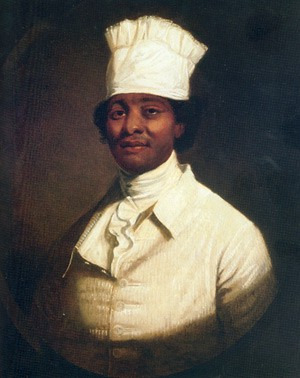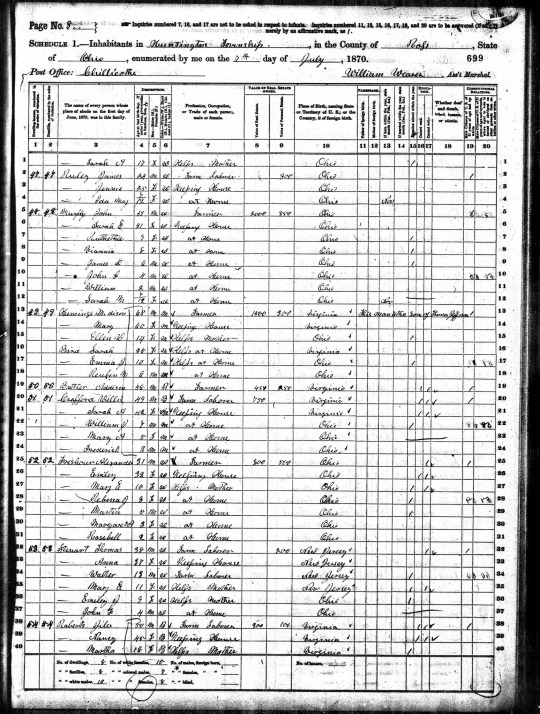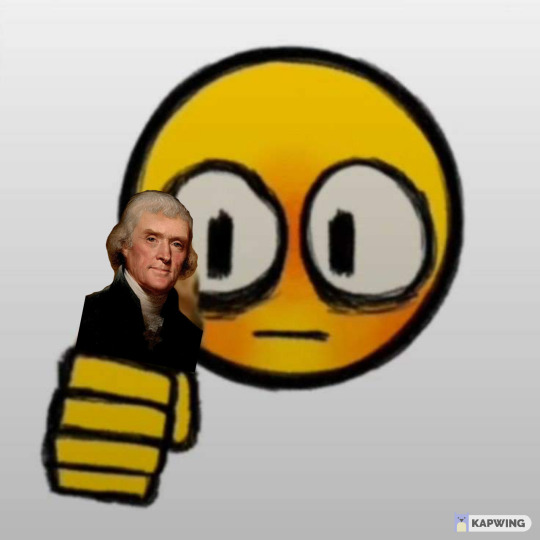#james hemings
Text
#talkin#tik tok#bhm#food#james hemings#macaroni and cheese#john young#buffalo wings#steve henson#ranch dressing#black history#black history month#george crum#george crumb#potato chip
746 notes
·
View notes
Text

James Hemings (1765-1801), an enslaved chef who worked under Thomas Jefferson. He was the first American to train as a chef in France and is credited for introducing macaroni and cheese into American culture. In 1802, Jefferson served "macaroni pie" at a state dinner, which was very likely Hemings' recipe, and the dish grew in popularity from then on.
88 notes
·
View notes
Text
Interesting information about the dessert he made for the Dinner-Table Bargain.
#alexander hamilton#james hemings#james madison#thomas jefferson#dinner table bargain#the room where it happens#baked alaska#master chef
11 notes
·
View notes
Text
R.I.P. James Hemings you would've crushed this challenge (The show basically challenges American chefs to learn French baking).


Good for him being an amazing chef 💪💪💪
I want to learn more about him. I've learned about him mostly at Monticello and the occasional original recipe in historical restaurants! In short, James Hemings was enslaved by Thomas Jefferson and trained in French cuisine during Jefferson's time there. He eventually negotiated his freedom and he is a sibling of Sally Hemings.
Here is Monticello's webpage about him if you want to learn more.
2 notes
·
View notes
Text
#sally hemings#thomas jefferson#jefferson in paris edit#jefferson in paris#movie amv#movie edit#movie#movie film#film#historical fiction#edits#edit#patsy jefferson#martha jefferson#maria cosway#james hemings
10 notes
·
View notes
Text
Speaking of France ...
Speaking of France …
You’re not supposed to begin a piece of writing with a question. Why not?
No idea, except that the “experts” seem to think that it’s an easy way out. “You can do better,” they say.
So what was my question? Oh yes.
Why is traditional French food so terribly unpopular at the moment?
Many authors and pundits have addressed that question in recent years, from Michael Steinberger’s Au Revoir to All…

View On WordPress
#clafoutis#Edward Behr#Eric Ripert#France#French cuisine#Haute Cuisine#Henri Soulé#James Hemings#Julia Child#Karen hess#Le Pavillon#Michael Steinberger#Michelin stars#Paul Freedman#The Virginia Housewife#Thomas Jefferson
0 notes
Text



𝔐𝔢𝔱𝔞𝔩𝔩𝔦𝔠𝔞, 𝔟𝔞𝔠𝔨𝔰𝔱𝔞𝔤𝔢 𝔡𝔲𝔯𝔦𝔫𝔤 𝔐𝔬𝔫𝔰𝔱𝔢𝔯𝔰 𝔬𝔣 ℜ𝔬𝔠𝔨 յգՑԴ 𝔱𝔬𝔲𝔯
📷 ℜ𝔬𝔰𝔰 ℌ𝔞𝔩𝔣𝔦𝔫
#Metallica#Ross Halfin#backstage#Monsters of Rock#1987#tour#The $5.98 EP - Garage Days Re-Revisited#The $5.98 EP - Garage Days Re-Revisited era#kirk hammett#james hetfield#lars ulrich#jason newsted#Genre:#Thrash Metal#hemes:#Introspection#Anger#Corruption#Deceit#Death#Life#Metal#USA
55 notes
·
View notes
Text
Here's a fun little thing i found:
Federal census of the year 1870 of Ross County, Ohio. Enumerator broke protocol to note of James Madison Hemings (mixed race son of Thomas Jefferson and Sally Hemings), the quoted note reads:
"This man is the son of Thomas Jefferson!"
I adore little pieces of history like this. Like, this isn't even necessary to put down in a census. Why is this in a census? Other than that, this was a pretty cool find.


6 notes
·
View notes
Text
Book 20 Founding Gardeners
Dewey gave me 718 Monuments; Mausoleums, Cemeteries. Very interesting subject matter, but a paucity of books forced me to go up to 71X Civic and landscape art. That brought Andrea Wulf's Founding Gardeners. It's an astounding look at how gardening influenced politics and vice-versa during the founding days of America.
The first three presidents, George Washington, John Adams, and Thomas Jefferson, were all avid gardeners and ran farms (*cough*plantations*cough*) back home even when they were in politics. Essentially wanting to get back home to his garden was a big motivator in Washington stepping down from power first at the end of the Revolutionary War and then after his second term as president. Adams and Jefferson, first best of friends, then worst of enemies, finally warm correspondents bonded and rebonded over gardens and gardening. And even fourth president James Madison retired to gardening his estate (plantation) after he retired.
The first chapter starts off with Washington in the direst of straits in the Revolutionary War, but writing to his estate manager about gardening minutia. I started to get itchy; "We know who's really doing the planting", essentially. And sure enough, 11 pages in when Washington gets home there is finally mention of the slaves doing the labor on these gardens. Now, John Adams only owned a 40 acre farm compared to the thousands -of-acres farms the 3 Virginians owned and he never owned a slave in his life. Adams and his son, John Quincy Adams, were the only of the first 12 presidents not to own slaves ever. Now, Jefferson (my friends are probably groaning right now having to hear this yet again) is my lowest of the low for keeping his own children with Sally Hemings as slaves. (He freed them when he died - Thanks so much, Dad). There was a scene where Jefferson was fondly looking out on his garden where his children's children were playing, and my heart just broke thinking about what his other kids must have felt seeing their dad being a real dad to his white children. Anyway, the whole story of these gardens and their owner's devotions to them would be sweet, if it weren't horribly tainted by the fact they were using slavery to build them.
There are some cool moments in the book: the Constitutional convention was deadlocked on the issue of representation in Congress and many members took a trip to a botanic garden. The next vote had enough changed votes that they were able to pass our current system and thus pass the Constitution. The votes that changed that day were all people who had been on the botanic garden trip, likely uncoincidentally. Jefferson (boooo!) was already planning the Lewis and Clark expedition when the Louisiana Purchase came through. It was just a coincidence that we were offered sale of the land beforehand. Jefferson hoped on the off chance that Lewis might bring him home a live mastodon. The design of the White House and Washington D.C. itself is a compromise of the Federalists wanting a grander capital and Jeffersonian Democrats wanting a more modest capital city.
SHOULD YOU READ THIS BOOK: I would recommend it. It's fascinating and gives you some insight into the Founding Fathers as people. The slavery part is uncomfortable, but so is any honest account of history. The secret to British gardens of the 1790s is delightful. My only surprise was that the Royal Society didn't make an appearance in the book!
ART PROJECT: I had a grand vision of a slave as mother earth/Gaea rising out of the earth with a farm on her back, but damn, I can't even begin to draw something like that without a reference. So, I drew the only place I felt comfortable drawing, John Adams' Peacefield. The plants are made from two brushes made of a portrait of John Adams.

#Founding Gardeners#andrea wulf#52books#52booksproject#dewey decimal system#john adams#peacefield#slavery#founding fathers#american history#american revolution#george washington#james madison#thomas jefferson#sally hemings
3 notes
·
View notes
Text
The USA Has the Separation of Church and State ~ Let Us Not Revert to Male Chauvinism ~ Nor One Brand of Religious Belief Over Another in the Halls of USA Government
Combining Church and State in state and federal regulations and as the Speaker of the House of Representatives is not what our Forefathers set up for the United States of America.
Freedom is freedom, not censorship, nor male domination. It is time to pull off the systemic racism bandage covering the infected national wound masking as a difference of opinion. Blaming religion and religion’s…

View On WordPress
#Annette Gordon-Reed#book banning#censorship#church and state#freedom#Harvard University#James Madison#John Adams#June 19#Juneteenth#Juonson#male chuvinism#racism#Republicans#slavery#Speaker of the House#Speaker of the House of Representatives#The Hemings of Monticello#Thomas Jefferson#Thomas Paine#US#USA#white
0 notes
Text




youtube
Race (2007)
My rating: 3/10
Pod Racing: The Movie, with all the hideous design, poor writing and janky production values of a bad video game cut scene.
#Race#Robert Brousseau#Scott Heming#Rhonda Smiley#Kevin O'Donnell#James Hereth#Kevin Lewis#Wheaton James#Youtube
1 note
·
View note
Text
#talkin#tik tok#food#recipes#nikki.mov#oreos#ice cream#james hemings#sally hemings#thomas jefferson#augustus Jackson
84 notes
·
View notes
Text
Americans [...] would sip the rich cocoa as a hot drink. Cocoa made its way to North America on the same ships that transported rum and sugar from the Caribbean and South America [...] and was heavily reliant on the labor of enslaved Africans throughout the diaspora. [...] [B]y the early 1700s, Boston, Newport, New York and Philadelphia were processing cocoa into chocolate to export and to sell domestically. Chocolate was popular in the coffeehouse culture and was processed for sale and consumption by enslaved laborers in the North. Farther south, in Virginia, cocoa was becoming [...] so popular that it is estimated that approximately one-third of Virginia’s elite was consuming cocoa in some form or another. For the wealthy, this treat was sipped multiple times a week; for others it was out of reach. [...]
The art of chocolate-making – roasting beans, grinding pods onto a stone over a small flame – was a labor-intensive task. An enslaved cook would have had to roast the cocoa beans on the open hearth, shell them by hand, grind the nibs on a heated chocolate stone, and then scrape the raw cocoa, add milk or water, cinnamon, nutmeg or vanilla, and serve it piping hot.
---
One of the first chocolatiers in the Colonies was an enslaved cook named Caesar.
Born in 1732, Caesar was the chef at Stratford Hall, the home of the Lees of Virginia, and in his kitchen sat one of only three chocolate stones in the Colony. The other two were located at the governor’s palace and at the Carter family estate, belonging to one of the wealthiest families in Virginia. Caesar was responsible for cooking multiple meals a day for the Lees and any free person who came to visit. [...]
---
The work was oppressive in the plantation kitchens at Christmas time. [...]
[T]hose working in the big house kitchen and as domestic laborers were expected to work around the clock to ensure a perfect holiday for the white family. The biggest task at hand was to cook and serve Christmas dinner, and chocolate was a favorite addition to the three-course formal dinner. [...] Oyster stew, meat pies, roasted pheasant, puddings, roasted suckling pig and Virginia ham are some of the many dishes that would be served in just one course. The night would finish with the sipping of chocolate: toasted, ground and spiced [...] and served in sipping-cups made specifically for drinking chocolate. [...]
---
Decades before the two well-known enslaved chefs, Monticello’s James Hemings and George Washington’s Chef Hercules, [...] Caesar was running one of the Colonies’ most prestigious kitchens inside of Stratford Hall, and making chocolate for the Lees and their guests. [...] [H]is son, Caesar Jr., lived nearby and was the postillion [...].
The stress of cooking the most important dinner of the year was combined with the fear of what was to come on Jan. 1. New Year’s Day was commonly known as heartbreak day, when enslaved folks would be sold to pay off debts or rented out to a different plantation. Jan. 1 represented an impending doom, and the separation of families and loved ones. [...] Caesar disappeared from the records by the end of the 18th century. By 1800, his son Caesar Jr. was still owned by the Lees, but as that year ended, Christmas came and went, and Caesar Jr. was put up for collateral by Henry Lee for payment of his debts.
---
The world Caesar lived in was one fueled by the Columbian Exchange, which was built from enslaved labor [...]: pineapples, Madeira wine, port, champagne, coffee, sugar and cocoa beans. These items traveled from plantation to dining room via the Atlantic trade, and were central to securing the reputation of Virginia’s plantation elite. The more exotic and delicious the food, the more domestic fame one would reap. Having cocoa delivered directly to your home, and having a chocolatier in the kitchen, were exceptional. It was through Caesar’s culinary arts that Stratford Hall became well-known throughout Colonial Virginia as a culinary destination.
---
All text above by: Kelley Fanto Deetz. “Oppression in the kitchen, delight in the dining room: The story of Caesar, an enslaved chef and chocolatier in Colonial Virginia.” The Conversation. 21 December 2020. [Bold emphasis and some paragraph breaks/contractions added by me.]
321 notes
·
View notes
Note
was thomas jefferson a slave owner?
Yes.

There is so much to say about it but unfortunately my current mental capacity to too small to make a long, logical post. I will summarize as best I can.
Disclaimer!: I still need to research a lot more about slavery at Monticello and black lives in the 18th century better in general. I have recently purchased the book "The Hemingses of Monticello" which I am sure will give me a good understanding on both.
Another great source is the Monticello website that has multiple pages on slavery at Monticello.
Thomas Jefferson is a wealthy Virginian plantation owner, meaning that he is in the upper class and a slave owner because of his plantation. A total of 600 people were enslaved at Monticello throughout Jefferson's lifetime. It is true that enslaved people at Monticello could have had much worse lives on other plantations, but we must keep in mind that they were not seen and treated as equal people.
The most notable enslaved family at Monticello are the Hemingses. When Thomas Jefferson married Martha Wayles Skeleton, the family was transferred from being Martha's property to being Thomas's. The Hemingses family was related to the family as Martha's father had affairs with an enslaved woman in the family. They were closer to their masters, as Martha had many half-siblings who were Hemingses. It is also well known that friendships and relationships were developed between enslaved people and their enslavers.
Two of the most notable Hemingses are Sally Hemings and James Hemings. Both of them were invited to France with Thomas after the death of Martha (this is actually much more complicated than I wrote it). James Hemings studied French cuisine in which he would serve as Monticello's cook. Sally Hemings's story is much more complicated. Thomas Jefferson had an affair with Sally starting in France. She is said to have looked a lot like Martha, which must be a factor in his decision, as she was the same age as his oldest daughter. Not much is known about their relationship, but it is known that Sally had 6 of his children. Because so little is known, we have to assume that because of the power imbalance, that it is classified as rape.
Jefferson did grant freedom to a few of his slaves and Martha Jr. granting freedom to Sally. Jefferson called slavery "[a hideous blot on mankind]" and illegalized slave trading ship, but his role as a plantation owner overshadows these actions greatly. Most of Jefferson's controversies come from his role in slavery.
7 notes
·
View notes
Text
If you look at American History. There's a ton of examples of slave owners taking credit for the accomplishments of their slaves. From vaccines to good food and everything in between.
What I would pay to try Chef James Hemming's delicious Mac n Cheese 🤌
-fae
255 notes
·
View notes
Photo

CANCER on stage in Germany during their "Death Shall Rise" European Tour back in October 1991... from L to R: James Murphy, John Walker & Ian Buchanan.
(scan from Thrash 'n Burn Magazine #5)
#CANCER#Death Shall Rise#Germany#European Tour#Tour#stage#1991#90s#90's#James Murphy#John Walker#Ian Buchanan#metal#Genre: Death/Thrash Metal#Thrash 'n Burn Magazine#hemes: Gore Horror Death Society#UK
44 notes
·
View notes